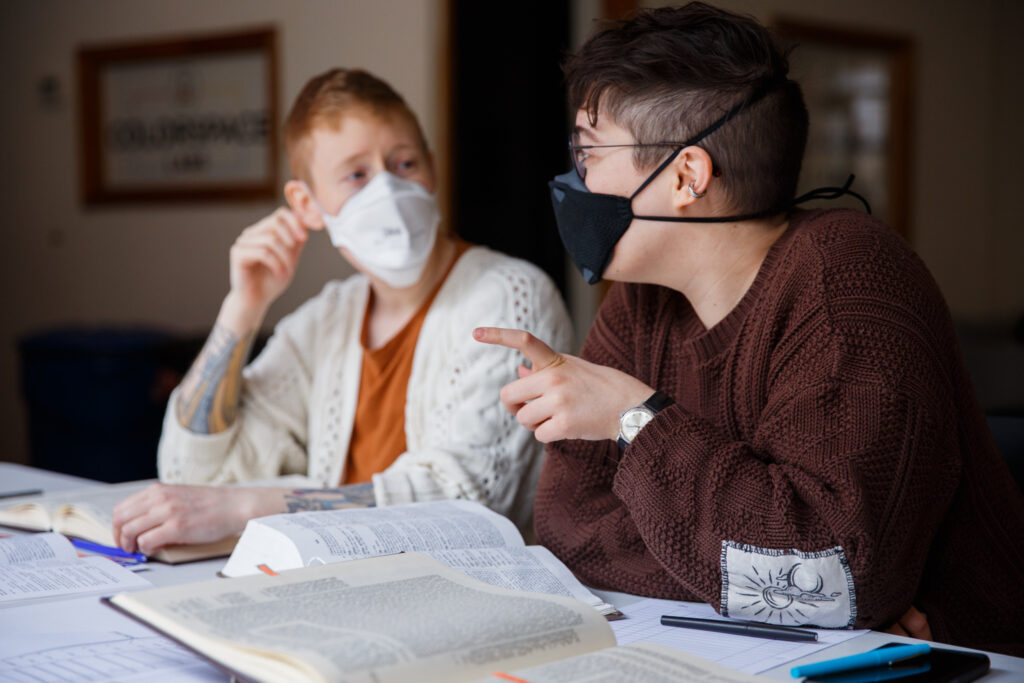Chanukah is one of our faves here at SVARA. And that’s, at least in part, because of the way the Rabbis so explicitly show us their work as they’re creating this newfangled holiday. They make sure we see, at every step, how they invented the holiday, and how they transformed it from one of militant violence into a tale of the miraculous, in which G!d’s presence is with those who resist while living under occupations.
This year we’ve reached a new level in our Chanukah fascination by doing what we do best, going inside on the word חנוכה. We took a journey into this word this week, and it brought us to a teaching that is at the heart of what this yeshiva is all about. If you’ve got your Jastrow handy, take a look. For the word חנוכה itself, Jastrow offers “inauguration” and “dedication,” specifically the “rededication of the Temple after its desecration under Antioch Epiphanes.” But Jastrow, of course, also points us to the root of the word: חנך, and defines it as “to polish,” “to initiate,“ or “to train [a child].” There are so many dimensions to this word!
And then, when you remember that the Hebrew word for “education”—חנוך—something we take very seriously here at SVARA—comes from the same root, well, now we’re off and running on the question of what the root of this word might tell us about what it means to educate. What does it really mean to teach? What are we actually trying to do, as teachers, when we teach?
This journey led us to a powerful text about learning and teaching called Chovat HaTalmidim, “The Responsibility of (or, perhaps better yet, “to”) The Learners” by the Piaseczner (pronounced “pee-ah-zech-ner”) Rebbe, Kalonymous Kalman Shapira, who founded a yeshiva and wrote and taught in Warsaw during the Shoah. He opens his book with an essay of advice to teachers about the project of teaching Torah and he begins with a line from Proverbs:
חנוך לנער על פי דרכו
גם כי יזקין לא יסור ממנה
Teach the child according to his way,
so that also in his old age he will not turn from it.
– Proverbs 22:6
The first section of this line from Proverbs—”Teach the child according to his way”—is something of a well-worn slogan among Jewish educators, and most teachers and commentators who cite it focus on the “על פי דרכו” (”according to his way”) part of the line. It is commonly understood to mean: Teach each child in the way that child learns best. This, of course, is good pedagogic advice, and offers a Jewish framework for a way of teaching that puts students at the center of learning, and honors the unique experiences that each student brings to a learning space.
But the Piaseczner Rebbe’s read of this line doesn’t stop there. In true SVARA style, he says that also digging into the word חנוך—”teach” (the same root as Chanukah!)—helps us find not just a source for student-centered learning, but also offers a completely different take on what education itself is really all about.
He realizes that Proverbs could have used the typical word for “teach”—מלמד––but doesn’t, and uses the word חנוך instead. Because the Rabbis teach us that G!d is not a blabbermouth, and we can derive infinite meaning from the precise language used in any given verse, the Piaseczner Rebbe uses this as an opportunity to explore what this specific word choice might have to tell us about education and learning.
While the word חנוך came to mean “educate,” its core multiple textures of meanings slant more toward “to dedicate” or “to initiate” (as we saw when we went on our Jastrow journey!). And the Piaseczner Rebbe tells us that it relates to the realm of craftsmanship. He explains that the root חנך refers to both doing the craft, and the process of readying the apprentice craftsman to learn that craft, or, in his language, readying the apprentice craftsman to “teach himself the craft by means of his teacher’s guidance.”
He then goes deep inside that word, and, with Rashi’s help, focuses on the way in which being mechanech (i.e., “educating”) someone is, essentially, to bring out in them the dispositions they need to do the work—whatever the work is—be it learning the craft of shoemaking or carpentry, or the work of being a crafter of one’s life, or one’s tradition:
“The term chinukh applies to the readying for a craft which is within the inner potential of a person to do; or the readying of a house or a vessel for a particular purpose. The word chinuch is specific. It is said about bringing out the readiness that is in a person or a thing from the potential to the actual. If we do not bring it out, it will stay hidden. So we need to bring out and ready (lechanekh) a particular person to do a particular craft, or a house or a vessel for its use—every room for the use for which it is meant, and every vessel for the use for which it was meant.”
This, he says, is the essence of chinuch, education as a practice or a craft. It’s not about transmitting information, and it’s not about trying to shape the student’s behavior, even toward the doing of good deeds. It is about readying students to find the particular disposition, the particular way of being, that lives inside of them, their unique purpose. This is the kind of learning, the Piaseczner Rebbe argues, that ensures the second half of the verse in Proverbs: גם כי יזקין לא יסור ממנה—”so that also in his old age he will not turn from it.” Learning that happens like craftsmanship, learning that grounds us in who we actually are and what we uniquely bring, that is the kind of learning that will never depart from us.
Without a doubt, the Piaseczner Rebbe’s teaching here sets a high bar. But at the same time, it felt so familiar to us when we read it, and so affirming of our understanding of what the Talmud is trying to do—or at least one of the things the Talmud is trying to do: to shape us into the kinds of people who…the kinds of people who are deeply empathic, profoundly connected to one another, who can hold their truths lightly, who can tolerate and appreciate the messiness of life, with all of its contradictions, paradoxes, uncertainties, complexities, and unknowns, who can see that which is hidden and not apparent, who will be challenging rather than compliant and active rather than passive in the pursuit of justice and liberation for all people.
To ready a person for that work, to help them develop the dispositions necessary to do that work, is what it means to teach. This is the curriculum of the Talmud. And to nurture and practice the living out of those dispositions is the enterprise of the bet midrash. This is the craft of learning and teaching. This Chanukah, may we all dedicate and rededicate ourselves to this practice of chinuch, the craft of truly shaping ourselves—and each other—so that our Torah stays with us forever.







